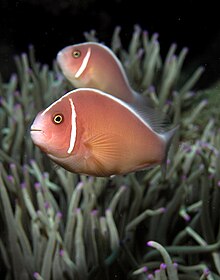Pink skunk clownfish
| Pink skunk clownfish | |
|---|---|
 |
|
|
Not evaluated (IUCN 3.1)
|
|
| Scientific classification | |
| Kingdom: | Animalia |
| Phylum: | Chordata |
| Superclass: | Osteichthyes |
| Class: | Actinopterygii |
| Order: | Perciformes |
| Family: | Pomacentridae |
| Genus: | Amphiprion |
| Species: | A. perideraion |
| Binomial name | |
|
Amphiprion perideraion Bleeker, 1855 |
|
Amphiprion perideraion also known as the pink skunk clownfish or pink anemonefish, is a species of anemonefish from the skunk complex that is widespread from northern Australia through the Malay Archipelago and Melanesia. Like all anemonefishes it forms a symbiotic mutualism with sea anemones and is unaffected by the stinging tentacles of the host anemone. It is a sequential hermaphrodite with a strict sized based dominance hierarchy: the female is largest, the breeding male is second largest, and the male non-breeders get progressively smaller as the hierarchy descends. They exhibit protandry, meaning the breeding male will change to female if the sole breeding female dies, with the largest non-breeder becomes the breeding male.
The body of A. perideraion is pink to peach. It has the white stripe along the dorsal ridge that is common to all members of the skunk complex and a white head bar running vertically just behind the eye. While the largest species of anemonefish can reach a length of 18 cm (7.1 in), A. perideraion is one of the smallest species with females growing to a length of 10 cm (3.9 in).
Some anemonefish species have color variations based on geographic location, sex and host anemone. A. perideraion, like other members of the skunk complex, does not show any of these variations.
A. perideraion is included in the skunk complex and so has similarities with other species in this complex. The combination of dorsal stripe and head bar distinguishes it from most other species. A. akallopisos, A. sandaracinos and A. pacificus all lack a white head bar, while A. nigripes lacks the dorsal stripe and has black belly and black pelvic and anal fins. The hybrid A. leucokranos has a broader head bar and the dorsal stripe does not extend the full length of the dorsal ridge.
...
Wikipedia
